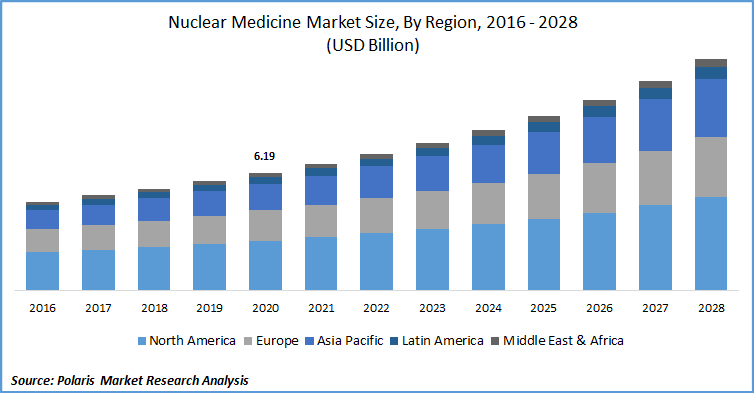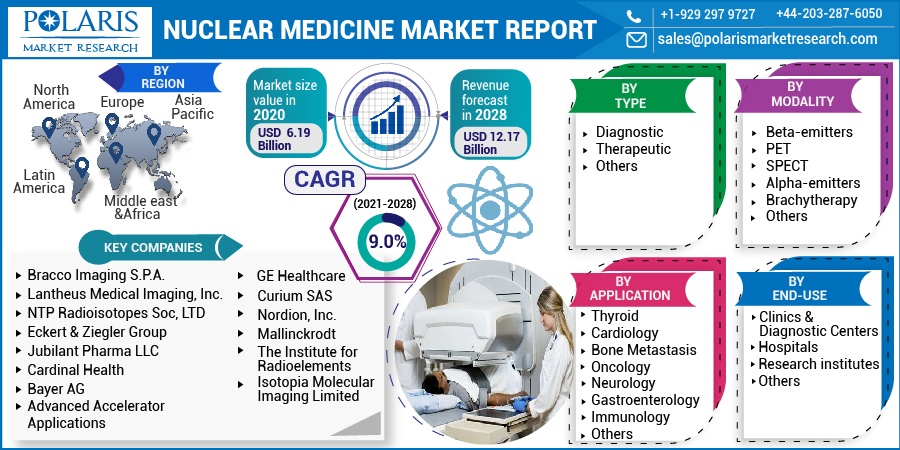
Nuclear Medicine Market Share, Size, Trends, Industry Analysis Report, By Type (Diagnostic, Therapeutic, Others); By Modality (Beta-emitters, PET, SPECT, Alpha-emitters, Brachytherapy, Others); By Application; By End-Use; By Regions; Segment Forecast, 2021 - 2028
- Published Date:Apr-2021
- Pages: 103
- Format: PDF
- Report ID: PM1848
- Base Year: 2020
- Historical Data: 2016-2019
Report Outlook
The global nuclear medicine market size was valued at USD 6.19 billion in 2020 and is anticipated to grow at a CAGR of 9.0% during the forecast period. Nuclear medicine involves the use of radiotracers for the diagnosis and treatment of cancer, neurological, cardiovascular, and other disorders at early stages. The radiotracers traverse through the body and emit gamma rays, which are detected by the camera, and processed by a computer to create a scan. Nuclear medicine is increasingly being used for the early detection of cancer. It also assists in planning treatment, analyzing the response, and reoccurrence of cancer.
 Know more about this report: Request for sample pages
Know more about this report: Request for sample pages
Nuclear medicine is capable of offering information about the tumor, metastasis, and remission. The imaging technology identifies the location of cancer cells and the possibility of treatment options. It is also used for applications such as renal scan, bone scan, lung scan, thyroid scan, and myocardial perfusion scan, among others.
The demand for therapeutic nuclear medicine is expected to increase during the forecast period. Radioactive iodine therapy is increasingly being used for the treatment of hyperthyroidism and thyroid cancer, whereas the use of radioactive antibodies is capable of treating lymphoma. Radioactive phosphorus is also used for the treatment of certain blood disorders.
The use of nuclear medicine offers enhanced treatment options for diseases such as cancer. It offers extremely high accuracy and precision in the detection of severe and complicated medical conditions, resulting in early-stage treatment. Nuclear medicine is capable of a detailed and exhaustive analysis of body functions and patient anatomy for effective diagnosis and treatment courses to be followed.
New product launches and acquisitions by leading players in the market have increased the adoption of nuclear medicine across the globe. In January 2018, Norgine B.V. introduced LYMPHOSEEK for distribution in Finland and Sweden. LYMPHOSEEK is a radiopharmaceutical aimed at providing effective diagnosis through nuclear medicine.
It is developed to be used for sentinel lymph node biopsy for diagnosis of breast cancer, and melanoma among others. In December 2018, Novartis acquired Endocyte, Inc., for the development of radioligand and CAR-T therapies for cancer treatment. The acquisition aims at expanding the company’s offerings in nuclear medicine and radioligand therapy for the diagnosis and treatment of cancer.
The global radiopharmaceuticals market is fueled by the growth in countries such as China, Japan, and India, the rising need to deliver effective healthcare services, the increasing geriatric population, growing cases of chronic diseases, and the need to provide enhanced patient experience. Global players are expanding into developing economies to tap market potential, further boosting the market growth.
Growing healthcare expenditure, changing lifestyles, and the introduction of supportive healthcare regulations would support the growth of the market. Technological advancements and significant investments in research and development further stimulate market growth for radiopharmaceuticals.

Know more about this report: Request for sample pages
Report Segmentation
The market is primarily segmented on the basis of type, modality, application, end-use, and region.
|
By Type |
By Modality |
By Application |
By End-Use |
By Region |
|
|
|
|
|
Know more about this report: request for sample pages
Type Outlook
On the basis of type, the market is segmented into diagnostic, therapeutic, and others. The diagnostic segment dominated the global radiopharmaceuticals market in 2019. Nuclear medicine uses radiotracers, which accumulate in tumors and provide accurate scans. Technetium-99m is used for diagnosis of heart diseases through PET. Nuclear medicine is also used for detection of thyroid through the use of radioactive iodine thyroid scan. Hepatobiliary iminodiacetic acid (HIDA) scans combined with technetium-99m are used for diagnosis of gallbladder problems.
Modality Outlook
On the basis of type, the market for nuclear medicine is segmented into diagnostic, therapeutic, and others. The diagnostic segment dominated the global radiopharmaceuticals market in 2019. Nuclear medicine uses radiotracers, which accumulate in tumors and provide accurate scans. Technetium-99m is used for the diagnosis of heart diseases through PET. Nuclear medicine is also used for the detection of the thyroid through the use of radioactive iodine thyroid scans. Hepatobiliary iminodiacetic acid (HIDA) scans combined with technetium-99m are used for the diagnosis of gallbladder problems.
Application Outlook
On the basis of application, the market is segmented into thyroid, cardiology, bone metastasis, oncology, neurology, gastroenterology, immunology, and others. Nuclear medicine is used to detect and diagnose coronary artery disease, analyze acceptance after heart transplant, and examine treatment options. It is also used for investigation of damage caused after heart attack, examine the effect of chemotherapy on heart function, and analyze the outcome of revascularization procedures.
End-Use Outlook
On the basis of application, the market is segmented into the thyroid, cardiology, bone metastasis, oncology, neurology, gastroenterology, immunology, and others. Nuclear medicine is used to detect and diagnose coronary artery disease, analyze acceptance after a heart transplant, and examine treatment options. It is also used for investigation of damage caused after a heart attack, examine the effect of chemotherapy on heart function, and analyze the outcome of revascularization procedures.
Geographic Overview
North America dominated the global nuclear medicine market in 2020. Increasing geriatric population, growing research and development activities, supportive regulations regarding the use of medical isotopes, and technological advancements are some factors attributed to the growth of this regional segment.
There have been increasing incidences of chronic diseases registered in the region, driving the growth of this region. Rising health concerns established healthcare infrastructure, and growing awareness regarding preventive healthcare and early diagnosis of diseases has increased the demand for nuclear medicine in the region.
Competitive Landscape
The leading players in the nuclear medicine market include Bracco Imaging S.P.A., Lantheus Medical Imaging, Inc., NTP Radioisotopes Soc, LTD, Eckert & Ziegler Group, Jubilant Pharma LLC, Australian Nuclear Science & Technology Organization, Cardinal Health, Isotopia Molecular Imaging Limited, Bayer AG, The Institute for Radioelements, Curium SAS, Advanced Accelerator Applications, Nordion, Inc., Mallinckrodt, and GE Healthcare.
Breast Implants Industry Developments
- April 2024: Curium announced the purchase of Eczacıbaşı-Monrol Nuclear Product Cot. According to Curium, the acquisition will increase its geographic reach and allow it to develop innovative radionuclide and radiopharmaceutical pipelines for both therapeutic and diagnostic applications.
- March 2024: A memorandum of understanding (MoU) linked to nuclear medicine collaboration was signed by Rosatom State Corporation and the Republic of Serbia's Ministry of Health.
